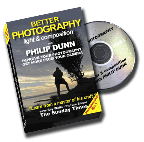
For this picture I have used a separate flash unit to add some details to the man’s face. Compare this shot to the one shown in Part 2. That was taken without flash.
The technique I use is desperately simple. If the shutter speed is set to ‘bulb’, or is slow enough (perhaps 1/2second or less), there is no need to connect the flash to the camera by any means – cables or infra-red. You can even hold the flash in one hand, point it at your subject and fire it manually just before you close the shutter. So – open the shutter - fire the flash – close the shutter. This is the way Victorian photographers worked over 100 year ago when they used flash powder… yes, I know, I’m an old git. The technique works just as well today with your electronic flash and digital camera. But the makers of hi-tech gear will not thank me for telling you.
The flash has lit the man’s face. I set the flash to ‘manual’ mode and put it on half power. This was just about right, taking into consideration the flash to subject distance, the f11 aperture set on the camera, and the brightness of the sparks. Experiment with your own flash unit you get the results you want. You can play with your flash guide numbers if you have the patience, but, frankly, to me life is too short.
The technique I use is desperately simple. If the shutter speed is set to ‘bulb’, or is slow enough (perhaps 1/2second or less), there is no need to connect the flash to the camera by any means – cables or infra-red. You can even hold the flash in one hand, point it at your subject and fire it manually just before you close the shutter. So – open the shutter - fire the flash – close the shutter. This is the way Victorian photographers worked over 100 year ago when they used flash powder… yes, I know, I’m an old git. The technique works just as well today with your electronic flash and digital camera. But the makers of hi-tech gear will not thank me for telling you.
The flash has lit the man’s face. I set the flash to ‘manual’ mode and put it on half power. This was just about right, taking into consideration the flash to subject distance, the f11 aperture set on the camera, and the brightness of the sparks. Experiment with your own flash unit you get the results you want. You can play with your flash guide numbers if you have the patience, but, frankly, to me life is too short.

For the picture of the glass-modeller (left) I used two flash units - one from behind the sitter to separate his dark hair from the black background.
Whatever you do, do not use too much flash power. This will destroy the atmosphere. To be effective, most of the light should come from the sparks themselves.
Sometime I do connect the flash to the camera with an extension cable, radio, or infra-red device. Then I prefer to set a fixed shutter speed on the camera (not ‘bulb’ mode). I also set the flash synchronisation mode to ‘rear’. This fires the flash at the end of the fixed exposure, just before the shutter is closed. The reason for firing the flash at the end of the exposure is to avoid the subject’s movement (they often jump) as soon as the flash goes off.
 TIP… It is vital that you brief your subject before you start. The subject’s head must be kept very still during the exposure.
TIP… It is vital that you brief your subject before you start. The subject’s head must be kept very still during the exposure.
TIP.. To find the ‘bulb’ setting is on your camera, set the camera to ‘M’ Manual exposure mode. Slow the shutter speed down as far as it will go. The ‘bulb’ setting is usually the next setting after 30-seconds.
Whatever you do, do not use too much flash power. This will destroy the atmosphere. To be effective, most of the light should come from the sparks themselves.
Sometime I do connect the flash to the camera with an extension cable, radio, or infra-red device. Then I prefer to set a fixed shutter speed on the camera (not ‘bulb’ mode). I also set the flash synchronisation mode to ‘rear’. This fires the flash at the end of the fixed exposure, just before the shutter is closed. The reason for firing the flash at the end of the exposure is to avoid the subject’s movement (they often jump) as soon as the flash goes off.
 TIP… It is vital that you brief your subject before you start. The subject’s head must be kept very still during the exposure.
TIP… It is vital that you brief your subject before you start. The subject’s head must be kept very still during the exposure.TIP.. To find the ‘bulb’ setting is on your camera, set the camera to ‘M’ Manual exposure mode. Slow the shutter speed down as far as it will go. The ‘bulb’ setting is usually the next setting after 30-seconds.


No comments:
Post a Comment